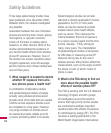
98
Medical instrumentation (AAMI). The final
draft, a joint effort by the FDA, medical
device manufacturers, and many other
groups, was completed in late 2000.
This standard will allow manufacturers
to ensure that cardiac pacemakers and
defibrillators are safe from wireless phone
EMI. The FDA has tested hearing aids
for interference from handheld wireless
phones and helped develop a voluntary
standard sponsored by the Institute of
Electrical and Electronic Engineers (IEEE).
This standard specifies test methods and
performance requirements for hearing
aids and wireless phones so that no
interference occurs when a person uses
a ‘compatible’ phone and a ‘compatible’
hearing aid at the same time. This
standard was approved by the IEEE in
2000. The FDA continues to monitor
the use of wireless phones for possible
interactions with other medical devices.
Should harmful interference be found
to occur, the FDA will conduct testing
to assess the interference and work to
resolve the problem.
12. Where can I find additional infor-
mation?
For additional information, please refer
to the following resources: FDA web
page on wireless phones (http://www.
fda.gov/cdrh/phone s/index.html) Federal
Communications Commission (FCC)
RF Safety Program (http://www.fcc.
gov/oet/rfsafety) International Commission
on Non-lonizing Radiation Protection
(http://www.icnirp.de) World Health
Organization (WHO) International EMF
Project (http://www.who.int/emf) National
Radiological Protection Board (UK) (http://
www.nrpb.org.uk/)
10 Driver Safety Tips
Your wireless phone gives you the
powerful ability to communicate by voice
almost anywhere, anytime. An important
responsibility accompanies the benefits
of wireless phones, one that every user
must uphold.
When operating a car, driving is your first
responsibility.
Safety Guidelines


















